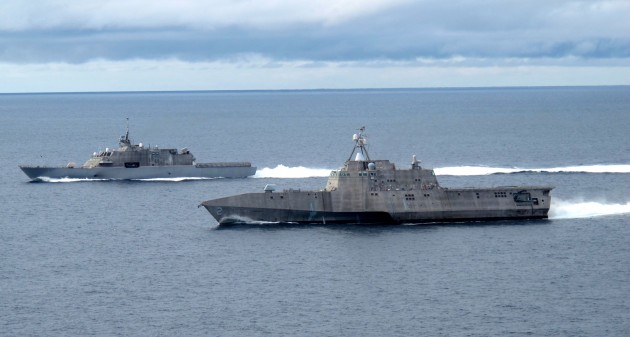LCS: GAO Says ‘Whoa,’ But It May Be Too Late, Cost Too Much To Slow
Posted on

The two Littoral Combat Ship variants, LCS-1 Freedom (far) and LCS-2 Independence (near).
WASHINGTON: The Navy’s Littoral Combat Ship program is moving so fast it may be too late to hit the brakes without LCS going entirely and expensively off the rails.
In a 72-page report to Congress that will be publicly released this morning, the Government Accountability Office makes a strong case that the Navy is buying LCS ships and equipment faster than the technology can be tested to make sure it all works. Three ships are already in the Navy, another seven are under construction, six more are paid for, and a final eight are under contract but not yet funded by Congress. Yet on the current schedule, GAO says, the Navy won’t have finished key tests of LCS’s much-disputed battleworthiness, such as “full ship shock trials,” until 2016. By that point, the nation will have paid for all 24 ships already under contract, and the Navy will be about to issue a second multi-ship “block buy” for more, heading towards a planned fleet of 52.
Meanwhile, of the three planned “mission modules” — essentially plug-and-play packages of equipment that turn an LCS into a minesweeper, a sub-hunter, or a small craft killed — the first, most complex, and most critical is the mine-warfare package, whose initial, limited-capability version won’t even begin operational testing until 2014, by which date the Navy will already have bought four of them. Before the full-up mine-clearing module completes testing in 2018, the Navy will have bought at least 13.
Procurement professionals call buying something you’ve not finished testing “concurrency,” and it’s been the bane of many programs, most notably the F-35 Joint Strike Fighter. You end up discovering problems in testing that require costly and awkward retrofits to what you’ve already built.
“A pause is needed,” the report says. But how do you pause the program now?
GAO does not exactly propose breaking the current contract. It does advise Congress to “freeze future funding” for the eight ships on contract but not yet paid for until the Navy provides more and better data on what the ships can do and what they’ll cost. (GAO doesn’t call for canceling those ships outright, but it does helpfully note that doing so would not require the government to pay termination fees). Then, when that current contract runs out in 2016, instead of continuing to buy two or three LCS a year as planned, the Navy should ramp down to “the minimum quantity and rate of ships required to preserve… the industrial base” pending a final Pentagon review.
The problem with this plan, as the Navy points out in its dissent, is that you get a lot fewer ships for what you spend. Going from three LCS a year to one, for example, will reduce costs, but not by two-thirds. Whether it’s high-tech weapons or toilet paper, the more you buy, the better the price you get on each item. That’s particularly true in defense procurement, where the government is the only customer, so suppliers size their workforce and facilities based on that one customer’s plans: If the government unexpectedly cuts its purchase, contractors are left with a lot of costly overhead, and they either go out of business or pass it along to the taxpayer. So while you buy fewer items, you’re paying a lot more for each of them.
Yes, GAO does suggest the Navy could ramp up production again once it’s satisfied Congress and the Office of the Secretary of Defense. But if there’s one thing even less cost-efficient than suddenly cutting back production, it’s slowing down and speeding up again. After you’ve reduced the rate at which you’re buying — and increased the price per item — the first time, the easiest course is to cut back again and again, increasing the unit price each time, a phenomenon known in the procurement business as a “death spiral.” The pressure would mount to cancel the Littoral Combat Ship altogether, which LCS critics of course would love.
The irony is that a “pause” would threaten one aspect of LCS where the Navy really has made progress — the price. The original goal was about $400 million a ship, half for the vessel proper (the seaframe) and half for the mission modules. The first few LCS, instead, ended up costing $600 to $700 million for the seaframe alone. Now the Navy and the contractors are wrestling the cost per seaframe down to $350 million, still more than promised. But because the mission modules are coming in much cheaper than expected — $100 million for the mine warfare package, $20-$30 million for the others — the average price for a whole ship is back to around the original $400 million.
That price may well go up again if production is in fact too fast, as GAO fears it is, and testing reveals problems requiring costly fixes to ships already built. But the price per ship will definitely go up if production slows down.
Even a few years ago, before the Navy signed the current contract in 2010, slowing down LCS construction so it didn’t get ahead of testing would have been a good idea. In fact, until 2005, the Navy had planned to buy just a couple of ships and then experiment with them for a while, before it realized the contractors couldn’t afford to set up production facilities for just two LCS and then idle them until the government made up its mind. Now the Navy has locked itself into a high-paced production plan that it may be too late to change without wasting more money.
Subscribe to our newsletter
Promotions, new products and sales. Directly to your inbox.
